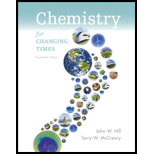
Chemistry For Changing Times (14th Edition)
14th Edition
ISBN: 9780321972026
Author: John W. Hill, Terry W. McCreary
Publisher: PEARSON
expand_more
expand_more
format_list_bulleted
Concept explainers
Question
Chapter 18, Problem 52P
Interpretation Introduction
Interpretation:
The molecular structure feature of a contraceptive steroid should be explained which makes it orally effective.
Concept introduction:
Oral contraceptive pills are most commonly used birth control method in world. It is taken by women which contains hormones like estrogen and progestin analogues. It controls natural response of body towards pregnancy. They inhibit ovulation by interaction with the progesterone receptor molecules.
Expert Solution & Answer
Want to see the full answer?
Check out a sample textbook solution
Chapter 18 Solutions
Chemistry For Changing Times (14th Edition)
Ch. 18 - Prob. 1RQCh. 18 - Prob. 2RQCh. 18 - Prob. 3RQCh. 18 - Prob. 4RQCh. 18 - Prob. 5RQCh. 18 - Prob. 6RQCh. 18 - What are prostaglandins? How do prostaglandins...Ch. 18 - Prob. 8RQCh. 18 - Prob. 9RQCh. 18 - Describe a synergistic effect involving drugs.
Ch. 18 - Prob. 11RQCh. 18 - Prob. 12RQCh. 18 - Prob. 13RQCh. 18 - Prob. 14RQCh. 18 - Prob. 15RQCh. 18 - Prob. 16RQCh. 18 - Prob. 17PCh. 18 - Classify the following drugs as natural,...Ch. 18 - Prob. 19PCh. 18 - Prob. 20PCh. 18 - Prob. 21PCh. 18 - Prob. 22PCh. 18 - Prob. 23PCh. 18 - Prob. 24PCh. 18 - Prob. 25PCh. 18 - Prob. 26PCh. 18 - Which of the following was originally marketed as...Ch. 18 - Prob. 28PCh. 18 - Which of the following is not considered to be an...Ch. 18 - How does heroin differ from morphine in its...Ch. 18 - Prob. 31PCh. 18 - How are endorphins related to (a) the anesthetic...Ch. 18 - Prob. 33PCh. 18 - Prob. 34PCh. 18 - Prob. 35PCh. 18 - Prob. 36PCh. 18 - Prob. 37PCh. 18 - Prob. 38PCh. 18 - Prob. 39PCh. 18 - Prob. 40PCh. 18 - Prob. 41PCh. 18 - Prob. 42PCh. 18 - Prob. 43PCh. 18 - Prob. 44PCh. 18 - Prob. 45PCh. 18 - Prob. 46PCh. 18 - Give three differences between hormones and...Ch. 18 - Prob. 48PCh. 18 - Prob. 49PCh. 18 - Prob. 50PCh. 18 - Prob. 51PCh. 18 - Prob. 52PCh. 18 - Prob. 53PCh. 18 - Prob. 54PCh. 18 - Prob. 55PCh. 18 - Prob. 56PCh. 18 - Prob. 57PCh. 18 - Which of the following is often treated with...Ch. 18 - Prob. 59PCh. 18 - Prob. 60PCh. 18 - Prob. 61PCh. 18 - Prob. 62PCh. 18 - Prob. 63PCh. 18 - Prob. 64PCh. 18 - Prob. 65PCh. 18 - Prob. 66PCh. 18 - Prob. 67PCh. 18 - What is an agonist? What is an antagonist?Ch. 18 - Prob. 69PCh. 18 - Prob. 70PCh. 18 - Prob. 71PCh. 18 - What is the difference between drug abuse and drug...Ch. 18 - Review the information on structure and function...Ch. 18 - Prob. 74APCh. 18 - Prob. 75APCh. 18 - Prob. 76APCh. 18 - Prob. 77APCh. 18 - Prob. 78APCh. 18 - Prob. 79APCh. 18 - Prob. 80APCh. 18 - Prob. 81APCh. 18 - Prob. 82APCh. 18 - Prob. 83APCh. 18 - Prob. 84APCh. 18 - Prob. 85APCh. 18 - Prob. 86APCh. 18 - Prob. 87APCh. 18 - Prob. 88APCh. 18 - Prob. 89APCh. 18 - Prob. 90APCh. 18 - Prob. 91APCh. 18 - Prob. 92APCh. 18 - Prob. 93APCh. 18 - Prob. 94APCh. 18 - Prob. 95APCh. 18 - Which of the following compounds are classified as...Ch. 18 - Prob. 97APCh. 18 - Prob. 98APCh. 18 - Prob. 99APCh. 18 - Prob. 100APCh. 18 - Prob. 101APCh. 18 - Prob. 102APCh. 18 - Prob. 103APCh. 18 - Prob. 104APCh. 18 - Prob. 18.1CTECh. 18 - Prob. 18.2CTECh. 18 - Prob. 18.3CTECh. 18 - Prob. 18.4CTECh. 18 - Prob. 18.5CTECh. 18 - Prob. 18.6CTECh. 18 - Prob. 18.7CTECh. 18 - Prob. 18.8CTECh. 18 - Prob. 1CGPCh. 18 - Prob. 2CGPCh. 18 - Prob. 3CGPCh. 18 - Prob. 4CGPCh. 18 - Prob. 5CGPCh. 18 - Prob. 6CGPCh. 18 - Prob. 7CGPCh. 18 - Prob. 8CGPCh. 18 - Prob. 9CGPCh. 18 - Prob. 10CGPCh. 18 - Prob. 11CGPCh. 18 - Prob. 12CGPCh. 18 - Prob. 13CGPCh. 18 - Prob. 14CGPCh. 18 - Prob. 1CHQCh. 18 - Prob. 2CHQCh. 18 - Prob. 3CHQ
Knowledge Booster
Learn more about
Need a deep-dive on the concept behind this application? Look no further. Learn more about this topic, chemistry and related others by exploring similar questions and additional content below.Recommended textbooks for you
 ChemistryChemistryISBN:9781305957404Author:Steven S. Zumdahl, Susan A. Zumdahl, Donald J. DeCostePublisher:Cengage Learning
ChemistryChemistryISBN:9781305957404Author:Steven S. Zumdahl, Susan A. Zumdahl, Donald J. DeCostePublisher:Cengage Learning ChemistryChemistryISBN:9781259911156Author:Raymond Chang Dr., Jason Overby ProfessorPublisher:McGraw-Hill Education
ChemistryChemistryISBN:9781259911156Author:Raymond Chang Dr., Jason Overby ProfessorPublisher:McGraw-Hill Education Principles of Instrumental AnalysisChemistryISBN:9781305577213Author:Douglas A. Skoog, F. James Holler, Stanley R. CrouchPublisher:Cengage Learning
Principles of Instrumental AnalysisChemistryISBN:9781305577213Author:Douglas A. Skoog, F. James Holler, Stanley R. CrouchPublisher:Cengage Learning Organic ChemistryChemistryISBN:9780078021558Author:Janice Gorzynski Smith Dr.Publisher:McGraw-Hill Education
Organic ChemistryChemistryISBN:9780078021558Author:Janice Gorzynski Smith Dr.Publisher:McGraw-Hill Education Chemistry: Principles and ReactionsChemistryISBN:9781305079373Author:William L. Masterton, Cecile N. HurleyPublisher:Cengage Learning
Chemistry: Principles and ReactionsChemistryISBN:9781305079373Author:William L. Masterton, Cecile N. HurleyPublisher:Cengage Learning Elementary Principles of Chemical Processes, Bind...ChemistryISBN:9781118431221Author:Richard M. Felder, Ronald W. Rousseau, Lisa G. BullardPublisher:WILEY
Elementary Principles of Chemical Processes, Bind...ChemistryISBN:9781118431221Author:Richard M. Felder, Ronald W. Rousseau, Lisa G. BullardPublisher:WILEY

Chemistry
Chemistry
ISBN:9781305957404
Author:Steven S. Zumdahl, Susan A. Zumdahl, Donald J. DeCoste
Publisher:Cengage Learning

Chemistry
Chemistry
ISBN:9781259911156
Author:Raymond Chang Dr., Jason Overby Professor
Publisher:McGraw-Hill Education

Principles of Instrumental Analysis
Chemistry
ISBN:9781305577213
Author:Douglas A. Skoog, F. James Holler, Stanley R. Crouch
Publisher:Cengage Learning

Organic Chemistry
Chemistry
ISBN:9780078021558
Author:Janice Gorzynski Smith Dr.
Publisher:McGraw-Hill Education

Chemistry: Principles and Reactions
Chemistry
ISBN:9781305079373
Author:William L. Masterton, Cecile N. Hurley
Publisher:Cengage Learning

Elementary Principles of Chemical Processes, Bind...
Chemistry
ISBN:9781118431221
Author:Richard M. Felder, Ronald W. Rousseau, Lisa G. Bullard
Publisher:WILEY
Lipids - Fatty Acids, Triglycerides, Phospholipids, Terpenes, Waxes, Eicosanoids; Author: The Organic Chemistry Tutor;https://www.youtube.com/watch?v=7dmoH5dAvpY;License: Standard YouTube License, CC-BY